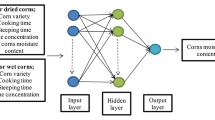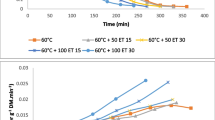Abstract
This study investigated mushroom powder rehydration using water, cornstarch, and potato starch as a rehydration medium. Wettability, dispersibility, and solubility were measured as the three main parameters of rehydration. Corn starch and potato starch were prepared at concentrations of 1, 2.5, and 5% and three temperatures of 30, 50, and 70 °C. Water was used as a control solution at three temperatures of 30, 50, and 70 °C. At a constant temperature, as starch concentration increased, it negatively affected wettability and solubility but positively affected dispersibility. The temperature of the rehydration medium also played a positive role in the rehydration of mushroom powder. According to our results, water, cornstarch, and potato starch were the best medium rehydration for mushroom powder, respectively. Multiple linear regression and an artificial neural network predicted rehydration process. Both models have a good ability to predict the rehydration of mushroom powder. However, the artificial neural network showed fewer RMSE than multiple linear regression. Moreover, Pearson correlation was used to determine the correlation between the rehydration process and different rehydration medium conditions. There were very high correlations between the rehydration parameter of mushroom powder by rehydration medium conditions in all rehydration mediums.







Similar content being viewed by others
References
T.A. Shittu, M.O. Lawal, Factors affecting instant properties of powdered cocoa beverages. Food Chem. 100, 91–98 (2007)
S. Nejatdarabi, M. Mohebbi, Effect of foam-mat drying condition on physical properties and rehydration behavior of mushroom powder. Iran. Food Sci. Technol. Res. J. 17, 1–16 (2021)
A. Marabi, M. Jacobson, S.J. Livings, I.S. Saguy, Effect of mixing and viscosity on rehydration of dry food particulates. Eur. Food Res. Technol. 218, 339–344 (2004)
A. Marabi, I.S. Saguy, Viscosity and starch particle size effects on rehydration of freeze-dried carrots. J. Sci. Food. Agric. 85, 700–706 (2005)
D. Saha, S. Bhattacharya, Hydrocolloids as thickening and gelling agents in food: a critical review. J. Food Sci. Technol. 47, 587–597 (2010)
C. Selomulya, Y. Fang, 15 - Food powder rehydration, in Handbook of food powders. ed. by B. Bhandari, N. Bansal, M. Zhang, P. Schuck (Woodhead Publishing, Sawston, 2013), pp.379–408
Y. Huang, L.J. Kangas, B.A. Rasco, Applications of artificial neural networks (ANNs) in food science. Crit. Rev. Food Sci. Nutr. 47, 113–126 (2007)
K. Erenturk, S. Erenturk, L.G. Tabil, A comparative study for the estimation of dynamical drying behavior of Echinacea angustifolia: regression analysis and neural network. Comput. Electron. Agric. 45, 71–90 (2004)
H. Hickey, B. MacMillan, B. Newling, M. Ramesh, P. Van Eijck, B. Balcom, Magnetic resonance relaxation measurements to determine oil and water content in fried foods. Food Res. Int. 39, 612–618 (2006)
P. Yu, M.Y. Low, W. Zhou, Design of experiments and regression modelling in food flavour and sensory analysis: a review. Trends Food Sci. Technol. 71, 202–215 (2018)
M. Argun, Prediction of moisture content of wet and dried nixtamal after alkaline cooking process by using artificial neural network. J. Food Meas. Charact. 16(4), 2922–2928 (2022)
J. Stangierski, D. Weiss, A. Kaczmarek, Multiple regression models and artificial neural network (ANN) as prediction tools of changes in overall quality during the storage of spreadable processed gouda cheese. Eur. Food Res. Technol. 245, 2539–2547 (2019)
N. Vásquez, C. Magán, J. Oblitas, T. Chuquizuta, H. Avila-George, W. Castro, Comparison between artificial neural network and partial least squares regression models for hardness modeling during the ripening process of swiss-type cheese using spectral profiles. J. Food Eng. 219, 8–15 (2018)
M. Zareef, Q. Chen, M.M. Hassan, M. Arslan, M.M. Hashim, W. Ahmad, F.Y.H. Kutsanedzie, A.A. Agyekum, An overview on the applications of typical non-linear algorithms coupled with NIR Spectroscopy in food analysis. Food Eng. Rev. 12, 173–190 (2020)
N. Jinapong, M. Suphantharika, P. Jamnong, Production of instant soymilk powders by ultrafiltration, spray drying and fluidized bed agglomeration. J. Food Eng. 84, 194–205 (2008)
H. Zhang, W. Xia, Y. Xu, Q. Jiang, C. Wang, W. Wang, Effects of spray-drying operational parameters on the quality of freshwater mussel powder. Food Bioprod. Process. 91, 242–248 (2013)
M. Fathi, M. Mohebbi, S.M.A. Razavi, Application of image analysis and artificial neural network to predict mass transfer kinetics and color changes of osmotically dehydrated Kiwifruit. Food Bioprocess Technol. 4, 1357–1366 (2011)
S.M.A. Razavi, S.M. Mousavi, S.A. Mortazavi, Dynamic prediction of milk ultrafiltration performance: a neural network approach. Chem. Eng. Sci. 58, 4185–4195 (2003)
C. Ratti, T. Kudra, Drying of foamed biological materials: opportunities and challenges. Drying Technol. 24, 1101–1108 (2006)
S. Hogekamp, H. Schubert, Rehydration of Food powders. Food Sci. Technol. Int. 9, 223–235 (2003)
L. Galet, T.O. Vu, D. Oulahna, J. Fages, The wetting behaviour and dispersion rate of cocoa powder in water. Food Bioprod. Process 82, 298–303 (2004)
J.J. Fitzpatrick, J. Salmon, J. Ji, S. Miao, Characterisation of the wetting behaviour of poor wetting food powders and the influence of temperature and film formation. Kona Powder Part. J 34, 282–289 (2017)
H. Ding, D.I. Wilson, W. Yu, B.R. Young, An investigation of the relative impact of process and shape factor variables on milk powder quality. Food Bioprod. Process. 126, 62–72 (2021)
I. Boiarkina, N. Depree, W. Yu, D.I. Wilson, B.R. Young, Rapid particle size measurements used as a proxy to control instant whole milk powder dispersibility. Dairy Sci. Technol. 96, 777–786 (2017)
A. Sharma, A.H. Jana, R.S. Chavan, Functionality of milk powders and milk-based powders for end Use Applications—A Review. Compr. Rev. Food Sci. Food Saf0 11, 518–528 (2012)
R. Jeantet, P. Schuck, T. Six, C. Andre, G. Delaplace, The influence of stirring speed, temperature and solid concentration on the rehydration time of micellar casein powder. Dairy Sci. Technol. 90, 225–236 (2010)
C.C. Nnaedozie, C. Sanders, E.C. Montes, L. Forny, G. Niederreiter, S. Palzer, A.D. Salman, Investigation of rehydration of food powder mixtures. Powder Technol. 353, 311–319 (2019)
X.D. Chen, N. Özkan, Stickiness, functionality, and microstructure of Food powders. Drying Technol. 25, 959–969 (2007)
S. Nejatdarabi, K. Parastouei, M. Fathi, Development of ajwain (Trachyspermum ammi) seed essence powder using foam-mat drying technique: a comparison on the effect of guar gum, basil seed gum, and the combination of them. J. Food Meas. (2022). https://doi.org/10.1007/s11694-022-01597-7
SE, Taylor, Rheology and structure of cornstarch suspensions in water-poly (propylene glycol) mixtures. J. Dispers. Sci. Technol. 34, 887–897 (2013)
R. Shogren, G. Biresaw, Surface properties of water soluble maltodextrin, starch acetates and starch acetates/alkenylsuccinates. Colloids Surf., A 298, 170–176 (2013)
M.C. Bourne, Chap. 1 - Texture, Viscosity, and Food, in Food Texture and Viscosity, 2nd edn., ed. by M.C. Bourne (Academic Press, London, 2002), pp.1–32
P.A.M. Steeneken, Rheological properties of aqueous suspensions of swollen starch granules. Carbohydr. Polym. 11, 23–42 (1989)
M. Alexander, D.G. Dalgleish, Dynamic light scattering techniques and their applications in food science. Food Biophys. 1, 2–13 (2006)
W.R. Mitchell, L. Forny, T. Althaus, G. Niederreiter, S. Palzer, M.J. Hounslow, A.D. Salman, Surface tension-driven effects in the reconstitution of food powders. Chem. Eng. Res. Des. 146, 464–469 (2006)
S. Wu, J. Fitzpatrick, K. Cronin, V. Maidannyk, S. Miao, Effects of spraying surfactants in a fluidised bed on the rehydration behaviour of milk protein isolate powder. J. Food Eng. 266, 109–694 (2020)
M.F. Machado, F.A.R. Oliveira, L.M. Cunha, Effect of milk fat and total solids concentration on the kinetics of moisture uptake by ready-to-eat breakfast cereal. Int. J. Food Sci. Technol. 34, 47–57 (1999)
W.K. Solomon, Hydration kinetics of direct expanded tef flour breakfast cereals in water and milk. Food Sci. Nutr. 2, 39–45 (2014)
Funding
This study was financed in part by the Ferdowsi University of Mashhad (Iran).
Author information
Authors and Affiliations
Corresponding author
Ethics declarations
Conflict of interest
The authors declare no competing interests.
Additional information
Publisher’s Note
Springer Nature remains neutral with regard to jurisdictional claims in published maps and institutional affiliations.
Rights and permissions
Springer Nature or its licensor (e.g. a society or other partner) holds exclusive rights to this article under a publishing agreement with the author(s) or other rightsholder(s); author self-archiving of the accepted manuscript version of this article is solely governed by the terms of such publishing agreement and applicable law.
About this article
Cite this article
Nejatdarabi, S., Mohebbi, M. Predicting the rehydration process of mushroom powder by multiple linear regression (MLR) and artificial neural network (ANN) in different rehydration medium. Food Measure 17, 1962–1973 (2023). https://doi.org/10.1007/s11694-022-01752-0
Received:
Accepted:
Published:
Issue Date:
DOI: https://doi.org/10.1007/s11694-022-01752-0




